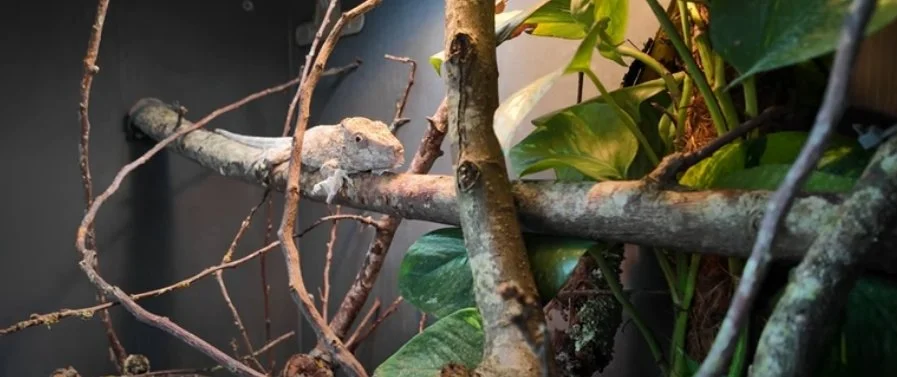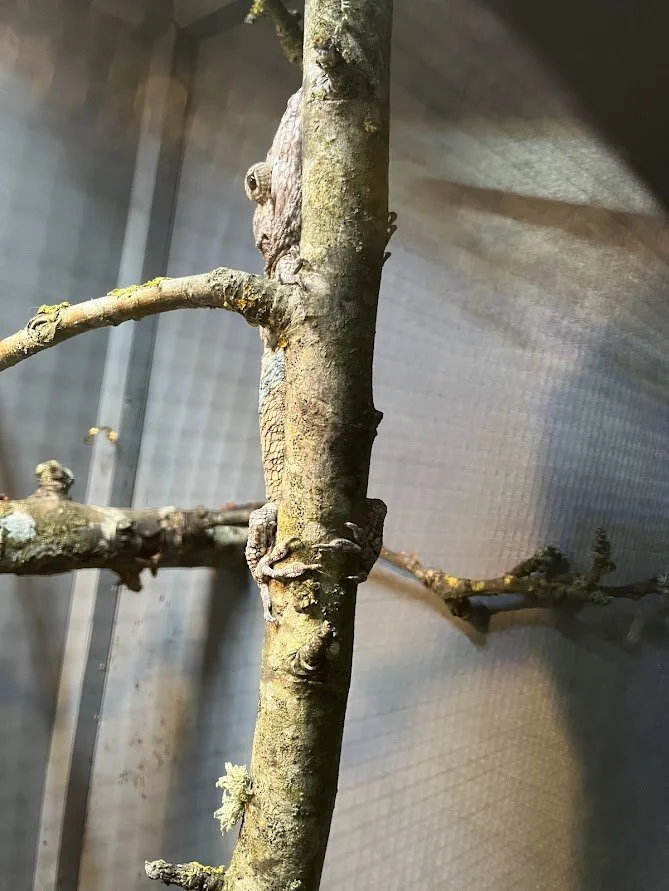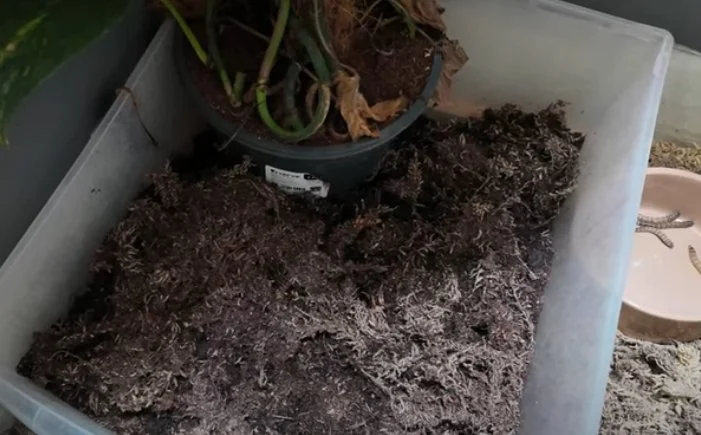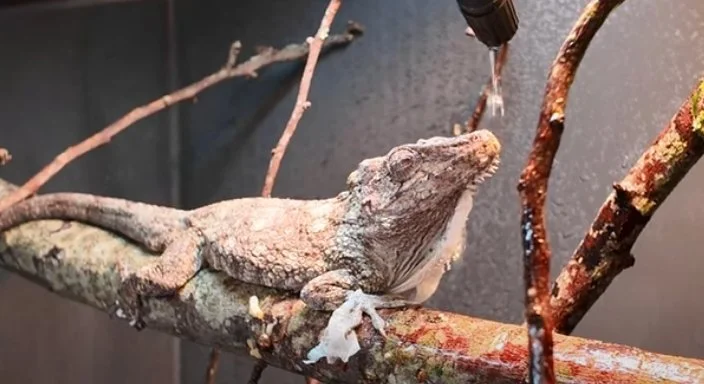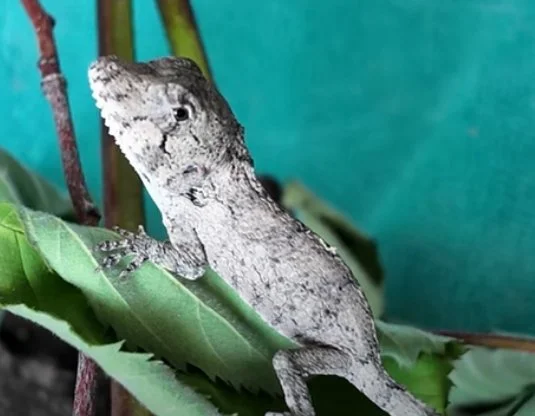False Chameleon (Anolis barbatus) Care Sheet
False Chameleons (Anolis barbatus) are a large anole species; they are sometimes called Bearded Anoles. Unlike true chameleons, they cannot change colour dramatically, although they will vary in shades depending on stress, emotions and temperatures. Their unusual appearance, most individuals have a calm demeanour (unless you are my male Norbert), and strong snail-crushing jaws have made them increasingly popular to keep in the reptile hobby.
Whereas most anoles are small, fast, and delicate, false chameleons are robust, slow-moving, and tolerant of captivity, making them well-suited for dedicated keepers. This is a species that seems to thrive in captivity when provided appropriate care.
Figure 1: My adult male Norbert.
Natural History
Taxonomy: Family Dactyloidae (formerly Iguanidae). Species group Anolis barbatus complex.
Geographic Range: Endemic to Cuba, inhabiting forests, gardens, plantations, and edge habitats.
Climate: Warm tropical conditions with seasonal rainfall.
Appearance: Large heads, blunt snouts, and “bearded” cream throat pouches. Colouration ranges from brown to grey to olive, often mottled for camouflage.
Behaviour: Primarily arboreal, perching quietly on branches or tree trunks. Movement is deliberate, almost chameleon-like. They tend to be clumsy and slow moving.
Diet in the Wild: Specialised feeders on snails and other hard-shelled invertebrates, supplemented with insects.
Figure 2: Male display with flag pouch.
Enclosure Design
Size & Layout
Minimum: 3ft x 2ft x 2ft aboreal set up for a single adult
Recommended: 4ft x 2ft x 2ft aboreal set up to allow climbing and natural behaviour.
Pairs/Groups: Males should not be housed together. One male with one or two females is possible if space allows. If you have a male with females, you need to have a separate tank to give the female a break from his pestering.
Style
Tall, arboreal vivarium with good ventilation. Hybrid glass and screen enclosures often work best. I keep in mesh vivariums with covered sides.
Large wooden aboreal vivariums or pvc can work if sealed appropriately
Figure 3: Norberts wooden vivarium.
Furnishings
Multiple sturdy branches at various angles. They like to rest on thin branches, especially to sleep, so a variety of textures and sizes of branches is important. In the wild, they would sleep on thin branches, and they would move if a predator tried to climb on the branch and give them a warning.
Dense foliage (live or artificial) for cover.
Elevated hides and basking perches.
They enjoy vertical branches which they can hide behind and traverse up and down the height of the enclosure
Naturalistic substrates such as soil, moss, coco husk and leaf litter to stabilise humidity.
For females they will lay in moist soil around the base of a plant. If you are trying to collect eggs it is better to have a lay box at the base with bark chips the rest of the flooring to deter her from laying elsewhere.
Figure 4: My female Cannoli using her vertical branch.
Figure 5: Cannoli the females laying bin.
Temperature
Basking Spot: 85–90°F (29–32°C).
Ambient: 75–80°F (24–27°C).
Cool Zone: 70–74°F (21–23°C).
Night: 65–70°F (18–21°C).
Humidity
Maintain 60–80% with daily misting.
Automatic misters are great tools, I programme them to go off every 5 hours in short 20-second bursts to give plenty of drinking opportunities
Allow enclosure to dry slightly between mistings to prevent stagnant air.
Figure 6: My male Norbert drinking from the mister droplets.
Lighting
They need a UVB on the top of the vivarium. If it is above mesh, it will need to be a 10% bulb, if it is within the enclosure a shade dweller or 5-7% bulb would be more suitable
UVB is essential for calcium metabolism and overall health.
They need a halogen or incandescent heat bulb
They need reptile-specific LED lighting for visual lighting and to help promote plant growth
Provide a 12-hour photoperiod.
Diet & Nutrition
False chameleons are specialized snail eaters, but in captivity they accept a range of feeders.
Captive-bred land snails (primary natural food; also provide natural calcium).
Insects: Crickets, dubia roaches, silkworms, hornworms, locusts and other soft-bodied insects.
Figure 7: My female Cannoli with her locust hat.
Feeding Frequency
Adults: Every 2–3 days.
Juveniles: Daily or every other day.
Supplementation
Calcium + D3: 1–2x per week with UVB, or 2–3x without.
Multivitamin: Once weekly.
Rotate feeders for nutritional variety.
Behavior & Temperament
Unlike most anoles, false chameleons are:
Calm, slow, and tolerant of human presence.
Rarely bite or display aggression, although you get the odd few who can be defensive
Often perch motionless for long periods, relying on camouflage.
Handling: They can be handled gently, though they are best appreciated as display animals. Always support their body fully, and keep sessions brief.
Figure 8: My female being handled.
Cleaning & Maintenance
Daily: Remove feces and uneaten food, replace water.
Weekly: Wipe down glass and check plants/branches.
Monthly: Deep clean enclosure, replace substrate if not bioactive.
Bioactive Systems: Work well, reducing cleaning needs if maintained properly with cleanup crew (isopods, springtails).
Health & Common Problems
Metabolic Bone Disease (MBD): Prevent with UVB and proper supplementation.
Dehydration: Signs include wrinkled skin and sunken eyes — improve misting and hydration.
Parasites: Common in wild-caught animals; routine vet checks or faecal tests are essential.
Respiratory Infections: Caused by low temps or stagnant, damp enclosures.
Obesity: Can result from overfeeding fatty feeders.
Breeding
False chameleons have been bred in captivity, though not commonly.
Sexing: Males have larger heads and more developed beards.
Pairing: One male to one or two females in a spacious enclosure.
Eggs: Females lay small clutches (1–2 eggs) in moist soil or substrate.
Incubation: Around 75–80°F, taking 60–90 days.
Hatchlings: Start with pinhead crickets, fruit flies, and tiny snails if available.
Figure 9: A baby my pair produced.
Enrichment and Observation
Offer a variety of climbing structures and basking perches.
Provide live plants for natural behaviours.
Rotate feeders and feeding methods (e.g., offering snails in a shallow dish).
Observe them at dusk — they are most active in the evening.
Pros & Cons for Keepers
Pros:
Unique, unusual appearance.
Calm temperament compared to other anoles.
Fascinating diet and feeding behaviour.
Cons:
Require snails as part of their diet.
Less colourful than true chameleons or green anoles.
Still relatively rare and more expensive than common anoles.
Shopping list:
Here is a collected shopping list for your convenience! Remember, if we wouldn’t use it ourselves it would not be here!
Enclosure
REPTI ZOO Large Tall Glass Reptile Tank 36"x18"x36"
MistKing – Starter Misting System
Heating and Lighting
Incandescent Heat Lamps
Zoo Med Repti Basking Spot Lamp
Exo Terra Intense Basking Spot
8 Outlet Surge Protector with Mechanical Timer
UVB T5 bulbs
Zoo Med ReptiSun T5 HO Terrarium Hood, 30"
Carolina Custom Cages Reptile 22" T5HO UVB 24W Standard Light Fixture, Bundle with 10.0 UVB Tube
Carolina Custom Cages Reptile 12" T5HO UVB 15W Standard Light Fixture, Bundle with 10.0 UVB Tube
LED Visible Light
Measurement Equipment
Inkbird Wireless Thermometer Humidity and Temperature Monitor
Substrate
Cleaning Equipment
F10 SC Ready to Use Veterinary Disinfectant



